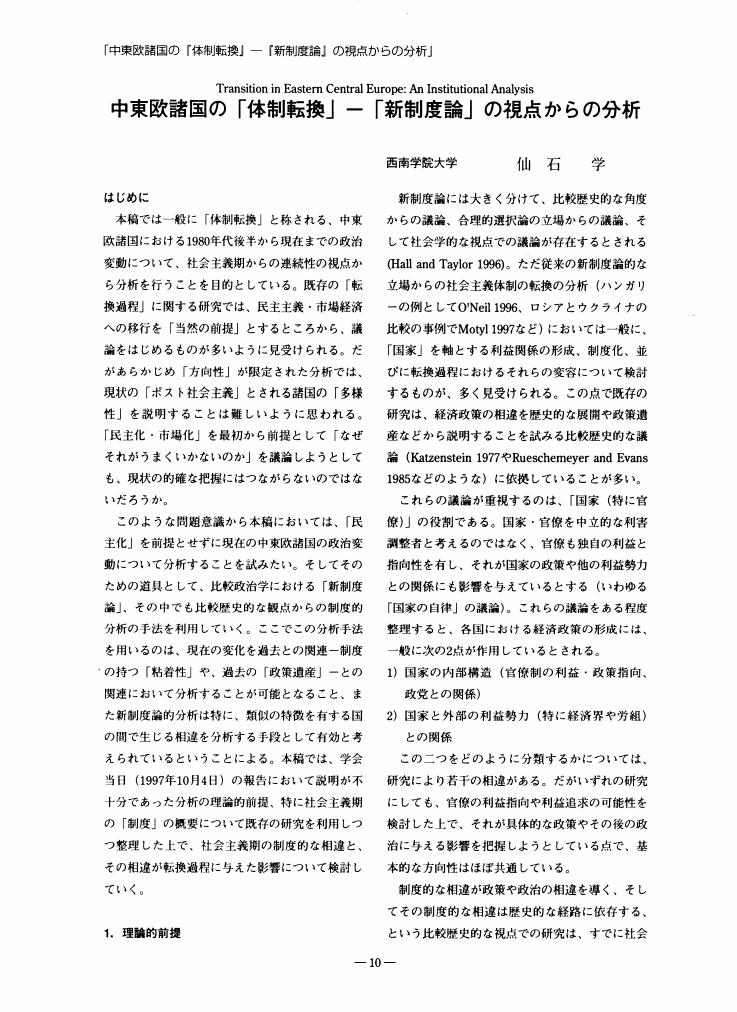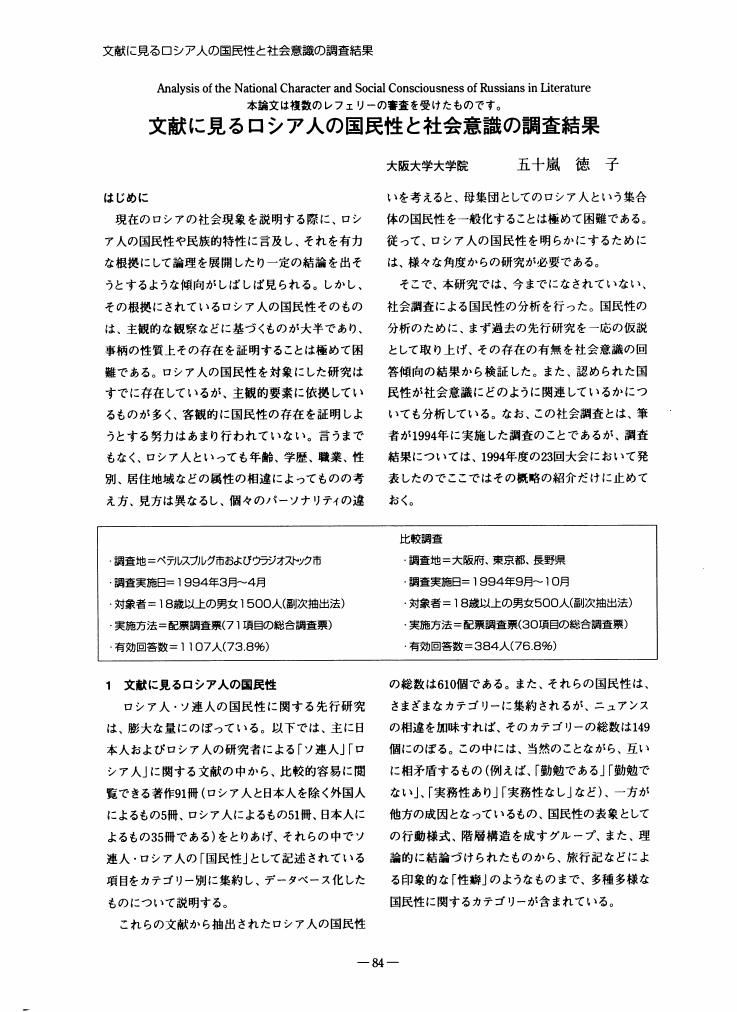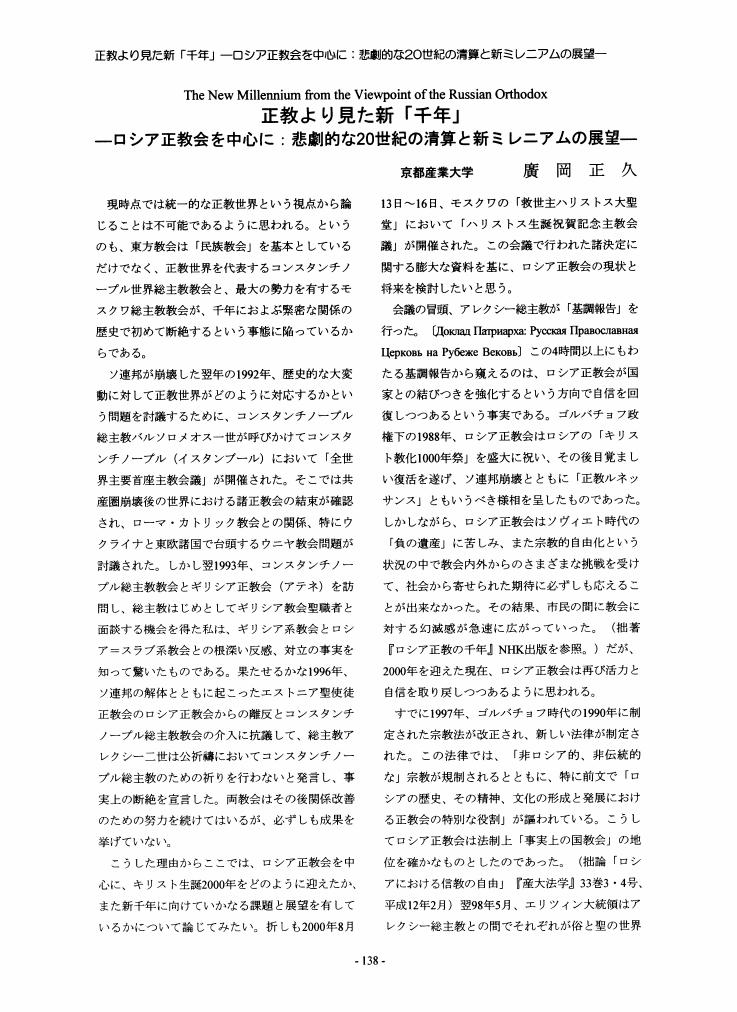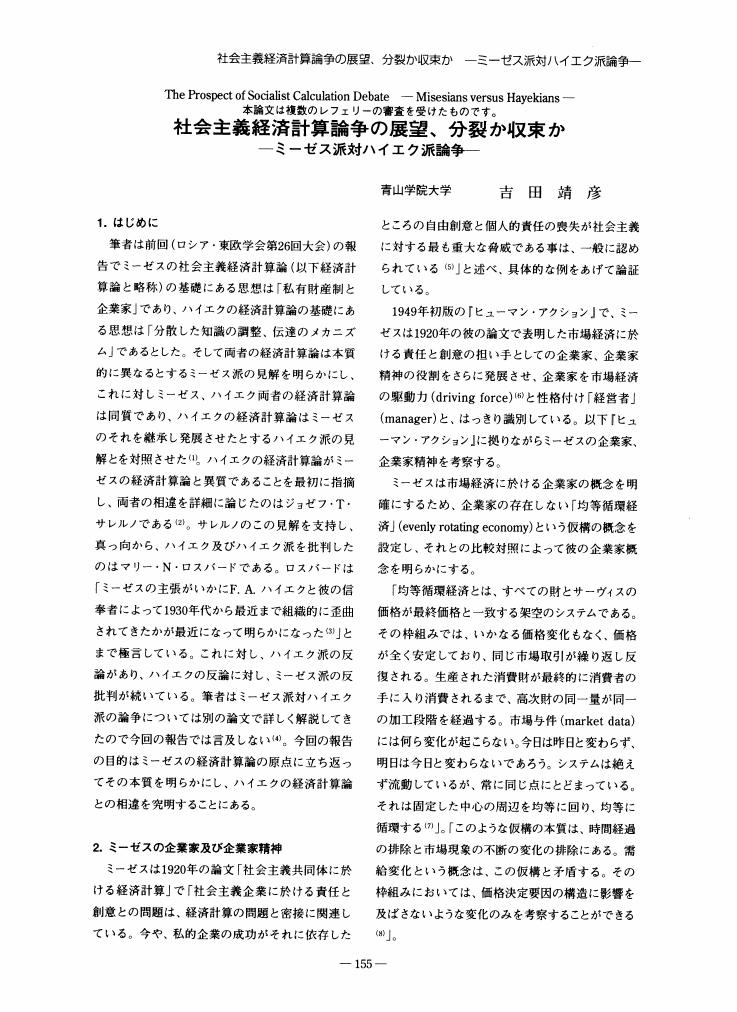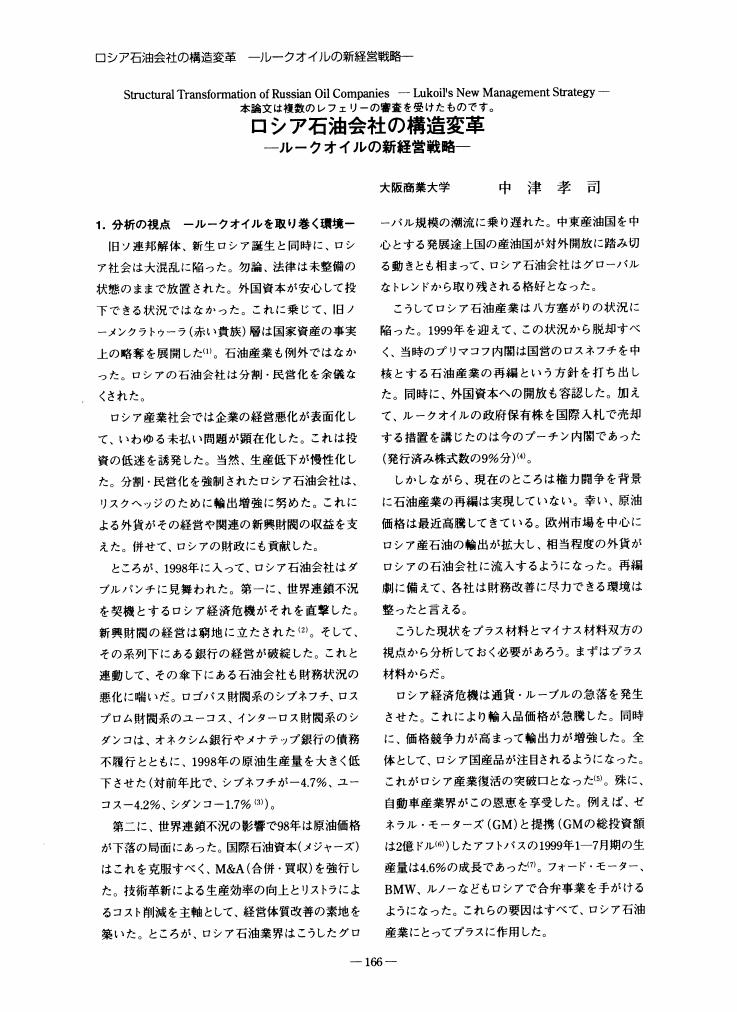2 0 0 0 OA ロシア改革の循環―利益分化と政治統合
- 著者
- 下斗米 伸夫
- 出版者
- ロシア・東欧学会
- 雑誌
- ロシア・東欧学会年報 (ISSN:21854645)
- 巻号頁・発行日
- vol.1997, no.26, pp.1-9, 1997 (Released:2010-05-31)
- 参考文献数
- 26
2 0 0 0 OA 中東欧諸国の「体制転換」―「新制度論」の視点からの分析
- 著者
- 仙石 学
- 出版者
- ロシア・東欧学会
- 雑誌
- ロシア・東欧学会年報 (ISSN:21854645)
- 巻号頁・発行日
- vol.1997, no.26, pp.10-18, 1997 (Released:2010-05-31)
- 参考文献数
- 15
2 0 0 0 OA 文献に見るロシア人の国民性と社会意識の調査結果
- 著者
- 五十嵐 徳子
- 出版者
- ロシア・東欧学会
- 雑誌
- ロシア・東欧学会年報 (ISSN:21854645)
- 巻号頁・発行日
- vol.1996, no.25, pp.84-90, 1996 (Released:2010-05-31)
- 参考文献数
- 8
2 0 0 0 OA ポスト・ソビエト期のロシア文学
- 著者
- 浦 雅春
- 出版者
- ロシア・東欧学会
- 雑誌
- ロシア・東欧学会年報 (ISSN:21854645)
- 巻号頁・発行日
- vol.1996, no.25, pp.54-63, 1996 (Released:2010-05-31)
- 著者
- 千年 篤
- 出版者
- THE JAPANESE ASSOCIATION FOR RUSSIAN AND EAST EUROPEAN STUDIES
- 雑誌
- ロシア・東欧学会年報 (ISSN:21854645)
- 巻号頁・発行日
- vol.2000, no.29, pp.95-104, 2000
It is widely noted that former socialist countries in Eastern Europe have suffered from the deterioration in social well-being during the period of transition to a market economy. How seriously has the living standard of people actually been threatened? To what extent has income inequality widened? In addition, how have people coped with economic hardships during the transition? This paper attempts to address these questions using quantitative measures where possible, with the Republic of Macedonia as a case of study. The focus is placed on the countermeasures taken by the people against economic hardships within the framework of social safety net.<BR>It is found that income inequality has widened across regions, accompanied by a concentration of economic activities in Skopje, the capital of the Republic. Also, economic inequality in the society has widened across generations; the young generation has been affected most seriously. In these contexts, people try to alleviate the deteriorating living standard by gaining income from multiple sources (including transfers from various social welfare programs, a withdrawal of savings and sales of properties) and by reducing daily expenditures such as for food, and clothes and shoes.<BR>In Macedonia, a formal safety net such as social welfare programs has undoubtedly helped sustain the level of living standard to a certain extent during the transition. However, at the same time the family system that is regarded as an informal safety net has played an important role in alleviating the declining living standard as well as in the widening of economic inequality both across regions and across generations during the transition.<BR>The family system with strong kinship ties is the distinct characteristic observed in Balkan societies. Thus, the analytical framework based on social safety net introduced in this paper is expected to provide a useful approach in analyzing social welfare problems in other Balkan countries during the period of transition to a market economy.
1 0 0 0 OA カトリック教会より見た新「千年」
- 著者
- 家本 博一
- 出版者
- ロシア・東欧学会
- 雑誌
- ロシア・東欧学会年報 (ISSN:21854645)
- 巻号頁・発行日
- vol.2000, no.29, pp.133-137, 2000 (Released:2010-05-31)
- 著者
- 廣岡 正久
- 出版者
- ロシア・東欧学会
- 雑誌
- ロシア・東欧学会年報 (ISSN:21854645)
- 巻号頁・発行日
- vol.2000, no.29, pp.138-140, 2000 (Released:2010-05-31)
1 0 0 0 OA 公開討論会「新『千年』を迎えての日口関係の展望」
- 出版者
- ロシア・東欧学会
- 雑誌
- ロシア・東欧学会年報 (ISSN:21854645)
- 巻号頁・発行日
- vol.2000, no.29, pp.145-165, 2000 (Released:2010-05-31)
1 0 0 0 OA 21世紀に向けたロシアの安全保障―新安全保障構想及び軍事ドクトリンを中心に―
- 著者
- 乾 一宇
- 出版者
- ロシア・東欧学会
- 雑誌
- ロシア・東欧学会年報 (ISSN:21854645)
- 巻号頁・発行日
- vol.2000, no.29, pp.31-39, 2000 (Released:2010-05-31)
- 参考文献数
- 5
Under the leadership of young and active President V. Putin, Russia has set forth on a new policy.In the field of national security, the president has designated Russia as a“strong power, ”in spite of Russia's severe economic condition. On the 10th of January 2000, Putin, acting President at that time, approved the new National Security Concept of the Russian Federation. He also approved the new Military Doctrine of the Russian Federation on the 21st of April. These two documents clearly state threat perceptions and measure to response the threat, which was not the case in the documents issued in the Yeltsin era.This paper aims to explore the concept of national security, which Russia is carrying towards the 21st Century under Mr. Putin's Presidency. The author compares the new National Security Concept and the new Military Doctrine with the previous ones. Drafts of these documents are also analyzed.One of the main findings is that Russia is concerned over NATO's adoption of the New Strategic Concept in 1999. Russia is extremely cautious of NATO's use of force outside the region, which, she sees, is neglect of the UN Security Council, and thus is a violation of principle of non-interference in domestic affairs. This concern led Russia to revise her threat perception. The perception of“war danger”described in the old documents is graded up to“war threat.”Although defensive doctrine and deterrence of war continue to be central figures of Russia's security concept, declaratory statement of“no first use of forces”has now been omitted. The new Military Doctrine clearly states that Russia would not abandon the option of nuclear first use, especially tactical nuclear weapons in case of large-scale wars and/or regional wars.
1 0 0 0 OA 中央・地方の二元論を超えて―政治間関係論とその比較分析の可能性―
- 著者
- 岡山 裕
- 出版者
- ロシア・東欧学会
- 雑誌
- ロシア・東欧学会年報 (ISSN:21854645)
- 巻号頁・発行日
- vol.2000, no.29, pp.41-48, 2000 (Released:2010-05-31)
- 参考文献数
- 15
While most of the nations in today's world are divided into multiple territorial units each governed by a non-central government, attempts to investigate the mechanisms of political complexity brought about by such spatial and governmental segmentation have been rare, if not totally absent. This essay seeks to overcome this situation by proposing a new analytical approach. Conventional understanding of the structure of domestic politics, represented by the ‘center-local relations’ model of intergovernmental relations, seems to have a couple of serious limits. First, it tries to interpret domestic politics unidimensionally according to the levels of government, making light of another dimension, that of space. Second, it focuses its attention to the interactions between governments of different levels, leaving out other political actors, such as political parties and interest groups. In its place, I will introduce a two-dimensional interpretation of domestic politics and an analytical approach based on it I call ‘interpolitical relations.’ This approach brings in a set of multi-level political process that involves all political actors for each of the two political dimensions. As to the spatial dimension, domestic politics will be classified according to the size of the territorial unit (polity) that has its own political process. In regard to the governmental dimension, the classification would be made according to the level of government. The resulting structure of the whole domestic politics, which I here call ‘interpolitical relations,’ will be determined by the combination of the state of relationships between different political levels in each dimension. As a measurement necessary to distinguish a set of interpolitical relations from another, I will introduce the degree of autonomy of a lower-level political process to its higher-level counterpart in each political dimension. This measurement pays attention to how much a lower-level politics in each dimension is organized without being influenced or dominated by its higher-level counterpart. In order to find out what type of interpolitical relations a nation's politics belongs to, I propose to examine the workings of constitutional system and party system of a nation, for these two systems play constitutional or constituent function in most, if not all, of modem constitutional democracies. How these systems divide or connect different levels of political process in two dimensions will be the subject of inquiry in determining the type of interpolitical relations. Having clarified the analytical framework and the research strategy of this approach, I apply it to post-Soviet Russian politics. In response to Peter Ordeshook who criticizes the current Russian constitutional structure for its inability to encourage the development of a nationwide party system that may politically ‘integrate’ the federation, I point out that while his analysis has the strength of paying attention to the interactions between different levels of political process in the governmental dimension, his unidimensional political image prevents him from acknowledging the diverse ways of organizing a stable federal system.
- 著者
- Арбахаи Магомедов
- 出版者
- ロシア・東欧学会
- 雑誌
- ロシア・東欧学会年報 (ISSN:21854645)
- 巻号頁・発行日
- vol.2000, no.29, pp.72-77, 2000 (Released:2010-05-31)
- 参考文献数
- 1
целb данной статЪи-анализ механизма реализции регионалЪного харизматического вождизма, основанного на лOкaлbном политическом обbединении мобилизациоHHого типа. рабта основана на изучении уHиkалЪньΙх характеристиTик традиционного типа злекTоралЪного повeдeния и политического лидерства в краснодарском крае B периoд, новейшей российской трансФормации 90-х годов.
1 0 0 0 OA 98年経済危機以降のロシアの失業問題
- 著者
- 粟田 聡
- 出版者
- ロシア・東欧学会
- 雑誌
- ロシア・東欧学会年報 (ISSN:21854645)
- 巻号頁・発行日
- vol.2000, no.29, pp.78-85, 2000 (Released:2010-05-31)
- 参考文献数
- 61
After the financial crisis, the unemployed people gradually increased in Russia. The number of them was over 10 millions in spring and summer in 1999. After the crisis, the many banks and financial companies were bankrupted. So, particularly the women who worked in banks lost their works. But the industries in Russia have developed gradually and the sphere of construction needed many workers. But they were mainly physical works, so it is hard for young people who graduated university to find their jobs. Now, many workers in Russia do not get regularly their salaries in their companies. So, unemployed women and many workers have to do second jobs. What kind of jobs they do? The unemployed women sell various goods in streets, or take care of sick people, old people and children. Or they translate foreign languages or teach them to children in home. These jobs are mostly works in black economy. In result, workers have gone away from the labor market. In future, the companies have to get more stable capitals. If so, workers in Russia will move into the normal labor market.
- 著者
- 荻野 晃
- 出版者
- ロシア・東欧学会
- 雑誌
- ロシア・東欧学会年報 (ISSN:21854645)
- 巻号頁・発行日
- vol.2000, no.29, pp.86-94, 2000 (Released:2010-05-31)
- 参考文献数
- 35
The aim of this paper is to examine the beginning of the reformer-line in Hungary. Hungary carried out reforms of its agricultural and economic systems after the mid 1960s. The author analyses how the Imre Nagy-problem influenced Hungarian domestic policy. Nagy was the Prime Minister during the Hungarian Revolution of 1956 and declared a renunciation of the one-party rule and a withdrawal from the Warsaw Pact. The Soviet army arrested him after the military intervention in Hungary of November 1956. After the Soviet military intervention, János Kádár, the First Secretary of the Hungarian Socialist Workers' Party, took over the reins of the government with the intention of domestic reform. But he couldn't carry out the reform because of the unstable domestic situation and relations with the Soviet Union. He had to restrain the Soviet Union from intervention in internal affairs in Hungary on the condition that he established the reformer-line. So he consolidated his hold on the country by oppressing opponents and restoring the old socialist system. Kádár executed Nagy in June of 1958. He took the initiative in the execution without instruction from the Soviet Union. Nagy's execution was the climax of the restoration of the socialist system after the Hungarian Revolution. Kádár tried to show the Soviet Union that executing Nagy had discontinued Nagy's radical reform. After the Nagytrial he gradually loosened domestic controls and established the reformer-line, within the one-party rule in the early of 1960s. The fast step of Hungarian reformer-line in the Kádár-era was to restore the socialist system at the end of 1950s.
1 0 0 0 OA 移行化過程の国民の痛みと社会的セーフティネット―マケドニア共和国を事例として―
- 著者
- 千年 篤
- 出版者
- ロシア・東欧学会
- 雑誌
- ロシア・東欧学会年報 (ISSN:21854645)
- 巻号頁・発行日
- vol.2000, no.29, pp.95-104, 2000 (Released:2010-05-31)
- 参考文献数
- 18
It is widely noted that former socialist countries in Eastern Europe have suffered from the deterioration in social well-being during the period of transition to a market economy. How seriously has the living standard of people actually been threatened? To what extent has income inequality widened? In addition, how have people coped with economic hardships during the transition? This paper attempts to address these questions using quantitative measures where possible, with the Republic of Macedonia as a case of study. The focus is placed on the countermeasures taken by the people against economic hardships within the framework of social safety net.It is found that income inequality has widened across regions, accompanied by a concentration of economic activities in Skopje, the capital of the Republic. Also, economic inequality in the society has widened across generations; the young generation has been affected most seriously. In these contexts, people try to alleviate the deteriorating living standard by gaining income from multiple sources (including transfers from various social welfare programs, a withdrawal of savings and sales of properties) and by reducing daily expenditures such as for food, and clothes and shoes.In Macedonia, a formal safety net such as social welfare programs has undoubtedly helped sustain the level of living standard to a certain extent during the transition. However, at the same time the family system that is regarded as an informal safety net has played an important role in alleviating the declining living standard as well as in the widening of economic inequality both across regions and across generations during the transition.The family system with strong kinship ties is the distinct characteristic observed in Balkan societies. Thus, the analytical framework based on social safety net introduced in this paper is expected to provide a useful approach in analyzing social welfare problems in other Balkan countries during the period of transition to a market economy.
1 0 0 0 OA ガス・パイプラインからみたウクライナ・ロシア関係―相互依存か従属か―
- 著者
- 藤森 信吉
- 出版者
- ロシア・東欧学会
- 雑誌
- ロシア・東欧学会年報 (ISSN:21854645)
- 巻号頁・発行日
- vol.2000, no.29, pp.105-113, 2000 (Released:2010-05-31)
- 参考文献数
- 32
Since independence, Ukraine has heavily relied on Russian gas. Many argue that Ukraine's energy dependency will affect Ukraine's security policy and will lead Ukraine to Russian satellite state (so-called “Second Belarus”) . They describe Ukraine-Russian relation as zero-sum games: Russia is an aggressive imperialistic state and Ukraine has less chance to counter this measure. However, many ignore that Russia also depends on Ukraine's gas pipeline. Without Ukraine, Russia cannot export her energy to European market. It seems that both countries have vulnerability to each other. In this paper, the possibility of interdependency between Ukraine and Russia will be discussed.Gazprom, the Russian gas giant, monopolizes the gas supply to Ukraine. Therefore, Ukraine has tried diversifying energy resources. Besides that, Ukraine has huge gas debts and its sum increases every moment. Gazprom demands to compensate for Ukraine's debts with Ukrainian strategic company's share such as gas pipeline systems. On the other hand, Russia also has vulnerability to Ukraine. 90% of Russian exported gas goes through Ukrainian territory. Ukraine controls tariff and sometimes illegally siphons off of Russian gas transiting Ukrainian territory. Therefore, Russia had no way but to agree with the debt-restructuring plan, which gave advantage to Ukraine.Both countries try to decrease their own vulnerabilities. Ukraine seeks alternative energy suppliers. Recently, Ukraine is building a pipeline to import Caspian oil. Due to financial problems, this route is so far incomplete. As for importing Turkmenistan gas, Ukraine has to pay transit fee to Russia. It is obvious that Turkmenistan gas does not contribute to decrease dependency on Russia. Russia also plans to build alternative gas pipelines, which bypass Ukraine. But these routes will not run for the next 10-15 years due to financial and technical problems.As discussed above, both countries are not successful seeking alternatives. For them, the most mutual benefited plan is further using existing pipeline. Then Ukraine could receive the transit fee, Russia saves huge investment capital (or save expensive transit fee for using the newly constructed pipeline) . However, the following problems must be resolved. First, Ukraine has to show her plan to clear huge gas debts. Under recent financial constraints, Ukraine has limited ways to clear debts such as cash emission, asking Russia to reconstruct debts, and selling (or leasing) pipeline systems. Second, Ukraine has to resolve “illegal siphon off”. Russia should ask Ukraine's guarantee or control the rights of pipeline. Under these circumstances, most controversial plan is selling the share of pipeline (wholly or partially) . Its merits are following: clear Ukraine's gas debts, attract Russian capital to renovate pipeline systems, and further transit Russian gas. However, there is a large opinion that joining Russian capital to Ukrainian energy sector should be dangerous to Ukraine's national security. They fear that Ukraine might completely lose the playing card. Since Western investors hesitate to invest in Ukraine, Russian capital is the only investor. Whether Russian or Westerner, the good investor for Ukraine is one who invests well in Ukraine. The worst scenario is that both sides increase suspicion to each other, Russia concentrates building up her alternative pipeline projects and abandons transiting through Ukrainian route. If both sides understand well their mutual benefits, then there should be interdependency between the two countries.
1 0 0 0 OA 経営政策の比較分析 ―ルークオイルとガスプロム―
- 著者
- 中津 孝司
- 出版者
- ロシア・東欧学会
- 雑誌
- ロシア・東欧学会年報 (ISSN:21854645)
- 巻号頁・発行日
- vol.2000, no.29, pp.114-123, 2000 (Released:2010-05-31)
- 参考文献数
- 36
In this article, we define management policy as management planning, which is the core of management strategy. We apply a light to Lukoil and Gazprom, which are typical companies of energy field in the Russian Federation, and try to analyze their management policy comparatively, in particular in the down-stream.Both Lukoil and Gazprom are, what is called, vertically integrated companies, but they can't enjoy the monopoly any longer. They have to strengthen the competitiveness of down-stream as well as of up-stream, in Europe and Asia. As far as the accomplishment of management policy and corporate governance is concerned, Gazprom is inferior to Lukoil, while the goal of Lukoil is to become an oil company such as British Petroleum, Royal Dutch Shell.
1 0 0 0 OA ユーラシア大陸の政治文化の覚醒 ―民族・宗教・文明の交錯― (日本語講演)
- 著者
- セルダヘイ イシュトヴァーン
- 出版者
- ロシア・東欧学会
- 雑誌
- ロシア・東欧学会年報 (ISSN:21854645)
- 巻号頁・発行日
- vol.2000, no.29, pp.125-131, 2000 (Released:2010-05-31)
1 0 0 0 OA 社会主義経済計算論争の展望、分裂か収束か ―ミーゼス派対ハイエク派論争―
- 著者
- 吉田 靖彦
- 出版者
- ロシア・東欧学会
- 雑誌
- ロシア・東欧学会年報 (ISSN:21854645)
- 巻号頁・発行日
- vol.1999, no.28, pp.155-165, 1999 (Released:2010-05-31)
- 参考文献数
- 36
1 0 0 0 OA ロシア石油会社の構造変革 ―ルークオイルの新経営戦略―
- 著者
- 中津 孝司
- 出版者
- ロシア・東欧学会
- 雑誌
- ロシア・東欧学会年報 (ISSN:21854645)
- 巻号頁・発行日
- vol.1999, no.28, pp.166-174, 1999 (Released:2010-05-31)
- 参考文献数
- 23
- 著者
- 富山 栄子
- 出版者
- ロシア・東欧学会
- 雑誌
- ロシア・東欧学会年報 (ISSN:21854645)
- 巻号頁・発行日
- vol.1999, no.28, pp.175-182, 1999 (Released:2010-05-31)
- 参考文献数
- 17

